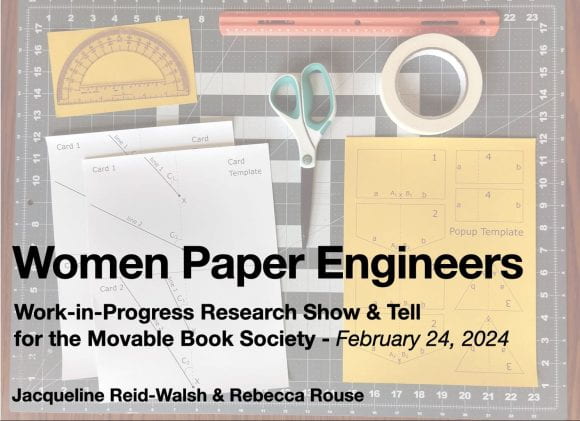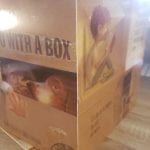By Jacqueline Reid-Walsh
On Saturday February 24, Rebecca Rouse and I had the privilege and pleasure of sharing a new research project with the Movable Book Society about Women Paper Engineers (you can watch the talk on YouTube). We began by contextualizing our topic within research on movable books generally. We connected some recurring questions that arise about terminology, the nature of movable books as a genre and with the invisibility of producers in library documentation. We observed that some producers (women) are less visible than others. Accordingly, we designed an initial survey to begin research mapping the field of women paper engineers.
Our questions are:
- Do you know of any women paper engineers, past or contemporary?
- Can you direct us to any examples of their work?
- Is there a female “Meggendorfer,” meaning a woman paper engineer who was or is prolific, innovative, and commercially successful on a mass scale?
Finally, we asked if they were comfortable sharing their email with us so we could contact them. We are extremely gratified by the tremendous response and by the insights and experiences by the respondents, many of whom are movable book makers themselves. We have the work for our project mapped out!
We had approached the Movable Book Society due to our interest in women (and girls) who make movable books domestically or commercially. This research interest stems from an article we co-wrote for the Journal of Children’s Literature in Education called, “Understanding the Design Values of Baby Books: Materiality, Co-presence, and Remediation.” In this piece we focused on the materials of baby books and their affordances in terms of interactivity. We became fascinated by women makers and designers of “indestructible” and multisensory baby books and how this work has been credited only recently (see my recent post for more on this article: https://sites.psu.edu/learningasplaying/2023/12/07/journal-launch-and-presentation-analyzing-the-interactivity-of-baby-books/).
I am a recent member of the movable book society and attended several recent formal and informal meetings. I was impressed by the breadth of members’ knowledge, their openness and the genuine good will among the members who range across the spectrum of movable book involvement. I was also struck by the gender of the award winners and some of the comments in the informal sessions. We took the opportunity to extend our research in this context, thanks to the auspices of the new Director of the Movable Book Society Dr. Suzanne Karr Schmidt, Curator of Rare Books and Manuscripts at the Newberry Library. We have all become mutually acquainted through our research on movable books and facilitated by our participation in the Pop-App Centre conferences and journal JIB (Journal of Interactive Books). Accordingly, Rebecca and I derived an informal survey that was approved and sent to all the society’s members as mentioned above.
In our initial survey, we had 25 respondents who shared over 148 names of women paper engineers from all over the world with us! We see this project as a long-term one, and we welcome more thoughts and comments.
We wanted to share this information with the readers of the “Learning as Play” blog and invite anyone interested in participating to email Jacqui at jxr67@psu.edu. Thanks!












